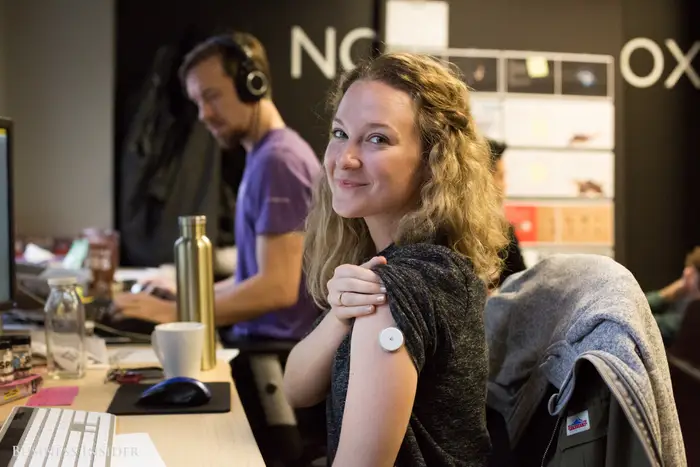The real-time insights into blood glucose levels provided by continuous glucose monitoring (CGM) technologies have changed the management of diabetes. Traditionally used for monitoring and managing diabetes, CGMs are now being explored as a tool for diagnosing diabetes. This blog delves into whether using continuous glucose monitoring can be effective in diagnosing diabetes, discussing its benefits, limitations, and how it compares to conventional diagnostic methods.
What is Continuous Glucose Monitoring?
Continuous glucose monitoring involves using a small sensor placed under the skin to measure glucose levels in the interstitial fluid. The sensor sends data to a receiver or smartphone app, providing real-time information about glucose levels throughout the day and night. This technology offers a comprehensive view of glucose fluctuations, which can be valuable for managing diabetes. However, its potential role in diagnosing diabetes is a topic of ongoing discussion.
The Traditional Methods of Diagnosing Diabetes
Traditionally, diabetes diagnosis relies on blood tests that measure glucose levels at a single point in time. Common diagnostic tests include:
Fasting Plasma Glucose (FPG)
Measures blood glucose after an overnight fast.
Oral Glucose Tolerance Test (OGTT)
Measures blood glucose levels before and after consuming a glucose-rich beverage.
Hemoglobin A1c Test
Measures average blood glucose levels over the past two to three months.
These tests provide a snapshot of glucose levels, helping healthcare providers diagnose diabetes based on specific thresholds. While these methods are effective, they have limitations, such as not capturing glucose fluctuations throughout the day.
Can Continuous Glucose Monitoring Be Used for Diagnosis?
Continuous glucose monitoring offers a more dynamic view of glucose levels compared to traditional tests. By tracking glucose fluctuations continuously, CGMs can provide a detailed picture of how glucose levels vary in response to food, exercise, and other factors. This real-time data can potentially aid in diagnosing diabetes by identifying patterns that may not be evident in single-timepoint tests.
More Read About : Should I Use a Continuous Glucose Monitor?
Benefits of Using Continuous Glucose Monitoring for Diagnosis
One of the primary benefits of using CGM for diabetes diagnosis is its ability to capture glucose variability. Traditional diagnostic tests provide information on glucose levels at specific times, which may not fully reflect an individual’s glucose patterns. CGMs, on the other hand, offer a comprehensive view of glucose trends over time, potentially revealing issues that single-point tests might miss.
Additionally, CGMs can help identify abnormal glucose responses to meals and stress, which are important indicators of diabetes. This continuous data can provide valuable insights for healthcare providers, enabling them to make more informed decisions about diagnosis and treatment.
Limitations and Considerations
Despite its advantages, continuous glucose monitoring has limitations as a diagnostic tool. One limitation is the cost of CGM devices, which may not be covered by insurance for diagnostic purposes. The financial burden of CGMs could be a barrier to widespread use for diagnosis.
Another consideration is the accuracy of CGM devices. While CGMs are generally reliable for monitoring glucose levels, their accuracy can be influenced by various factors, such as sensor calibration and individual variability. For diagnostic purposes, it is crucial to ensure that the data provided by CGMs is accurate and consistent.
Moreover, continuous glucose monitoring requires regular calibration and maintenance. The need for frequent adjustments and the potential for user error may impact the effectiveness of CGMs as a diagnostic tool. Healthcare providers must weigh these factors when considering CGMs for diagnosing diabetes.
Comparing CGMs to Traditional Diagnostic Methods
Continuous glucose monitoring offers a more detailed view of glucose fluctuations compared to traditional diagnostic tests. However, it is not yet a replacement for established diagnostic methods. Traditional tests, such as fasting plasma glucose and oral glucose tolerance tests, remain the gold standard for diagnosing diabetes due to their simplicity and reliability.
CGMs can complement traditional tests by providing additional data on glucose patterns and variability. Combining CGM data with traditional diagnostic methods can offer a more comprehensive assessment of an individual’s glucose status. This integrated approach may improve the accuracy of diabetes diagnosis and help tailor treatment plans.
Future Perspectives on CGMs and Diabetes Diagnosis
As technology continues to advance, the role of continuous glucose monitoring in diagnosing diabetes may evolve. Future developments in CGM technology could enhance its accuracy, affordability, and ease of use, making it a more viable option for diagnosis.
Research is ongoing to explore the potential of CGMs in detecting early signs of diabetes and prediabetes. Improved algorithms and data analysis techniques could enhance the diagnostic capabilities of CGMs, providing more precise and actionable information for healthcare providers.
Conclusion
Continuous glucose monitoring offers valuable insights into glucose fluctuations and has the potential to aid in diagnosing diabetes. While it is not yet a replacement for traditional diagnostic methods, CGMs can provide additional data that complements existing tests. By capturing a comprehensive view of glucose patterns, CGMs may enhance the accuracy of diabetes diagnosis and help identify individuals at risk.
As technology advances, the role of CGMs in diagnosis may continue to expand, offering new opportunities for early detection and personalized treatment. For now, healthcare providers should consider the benefits and limitations of CGMs when evaluating their use for diagnosing diabetes.


